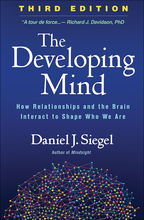 by Daniel J. Siegel
by Daniel J. Siegel
This highly influential work—now in a revised and expanded third edition incorporating major advances in the field—gives clinicians, educators, and students a new understanding of what the mind is, how it grows, and how to promote healthy development and resilience.
Full Description:
<P>This highly influential work—now in a revised and expanded third edition incorporating major advances in the field—gives clinicians, educators, and students a new understanding of what the mind is, how it grows, and how to promote healthy development and resilience. Daniel J. Siegel synthesizes cutting-edge research from multiple disciplines, revealing the ways in which neural processes are fundamentally shaped by interpersonal relationships throughout life. And even when early experiences are not optimal, building deeper connections to other people and to one's own internal experience remains a powerful resource for growth. Professors praise the book’s utility in courses from developmental psychology and child development to neuroscience and counseling.
<P>New to This Edition
<P> Incorporates findings from a huge body of recent research; over 1,000 citations added.
<LI> Revisits and refines the core hypotheses of interpersonal neurobiology.<LI> Chapter on the experience of belonging and the development of identity.
<LI> New or expanded discussions of behavioral epigenetics, the default mode network of the brain, social neuroscience, cultural and gender issues, theory of mind, the Wheel of <P><LI>Awareness contemplative practice, the science of consciousness, and more.
Introduction. “What Is the Mind, Anyway?”: An Interpersonal Neurobiology Perspective
1. The Embodied Brain, Awareness, and the Nature of Energy
2. States of Mind: Cohesion, Subjective Experience, and Complex Systems
3. Memory and Narrative
4. Attachment and a “Sense of Self”
5. Emotion as Shifts in Integration
6. Representations and Mental Reality: Modes of Processing and the Construction of Reality
7. Regulation and Coherence
8. Interpersonal Connection and the Relational Mind
9. Integration Within and Between
10. Belonging, “Self,” and an Integrated Identity as Me plus We = MWe: A Framework for Cultivating Integration
Glossary
Notes
References
Index
|